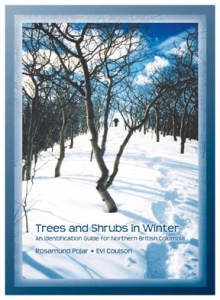Creekstone Press Publications
Excerpts from Trees and Shrubs in Winter
Introduction
For the first edition of this guide the focus was on the typical interior shrubs found in the Skeena River watershed and in particular around the communities of Hazelton, Houston and Smithers. For this second edition, we have expanded the geographical range that the guide covers. It now includes common woody shrub and tree species that can be found in the interior of BC from Williams Lake north to the Yukon border. Also included are a few of the more common shrub and tree species that are found closer to the coast in the northern half of BC.
The guide also includes most of the common coniferous trees in BC, even some that are not found naturally in this part of the province. Some of these are species that may have been planted in cut blocks. All the species mentioned are native to British Columbia.
Because this book was originally designed for people working in natural resource management, especially forestry, we focused attention on the recognition of species that were useful as indicator species of the different forested Biogeoclimatic Zones in the region such as Coastal Western Hemlock (CWH), Engelmann Spruce?Subalpine Fir (ESSF), Mountain Hemlock (MH), Interior Cedar Hemlock (ICH) and Sub?Boreal Spruce (SBS). By extending the scope of the book, additional forested BEC zones are now included i.e. Boreal White and Black Spruce (BWBS), Spruce Willow Birch (SWB) in the north and Sub?Boreal Pine?Spruce (SBPS) and Montane Spruce (MS) in the Chilcotin. None of the shrubs typical of the Alpine Tundra (e.g. heathers) are included in this book.
Willows (Salix species) are very hard to separate in winter and need catkins and leaves to identify them properly. Similarly, deciduous species of Vaccinium (blueberries and huckleberries) are difficult to separate based on winter features. We have made no attempt to sort them out here.
Names of Plants and Nomenclature
The Latin and common names of the plants follow MacKinnon et al (1994) and Pojar and MacKinnon (1996). Latin names are less ambiguous, more widely accepted, and more stable than common names. All Latin names have 2 parts (the binomial) and are italicized because they are a foreign language. The first part of the Latin name is the genus (which is roughly equivalent to our surname), and the second part is the species name (roughly equivalent to our Christian name). When talking about a plant, both parts of the binomial should be used wherever possible. The genus tells the listener something about what grouping the plant fits into – all species very closely related are in the same genus. Closely related genera (plural of genus) are then grouped together in the same Family. Family names are not Latin words – hence they are not italicized, but they always end in ‘aceae’. We have provided the Family names with each plant described.
Learning Latin may sound like a chore for most people, but think about how easily we pick up all that new computer jargon. Many former students have initially balked at the idea of learning Latin, only to complain a mere three months later that they cannot remember the common names any more. We encourage the reader to learn the Latin, but we have included the common names as well.
How to Use this Guide
The guide starts with a very simple key to separate shrubs from trees. Sometimes it is not always clear if the plant should be considered a shrub or a tree – especially if it is a young sapling – so some species may appear in more than one key in the book. The first key also divides trees into deciduous or coniferous and the shrubs into smaller groups depending on the arrangement of the buds and whether or not they are evergreen. This first key will direct the reader to the correct section of the book. The sections are:
• Coniferous trees
• Deciduous trees
• Deciduous shrubs with opposite buds
• Deciduous shrubs with alternate buds
• Evergreen shrubs
Once you are in the correct section, there is a second key that will take you to the genus and species (or genus only for some, e.g. willows). Species in each section are arranged alphabetically. Descriptions of species that are similar and which could easily be confused are given where appropriate.
We have tried to keep the botanical terminology as simple as possible, but some terms are described in the glossary at the back of the book.
